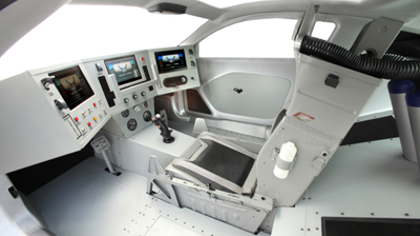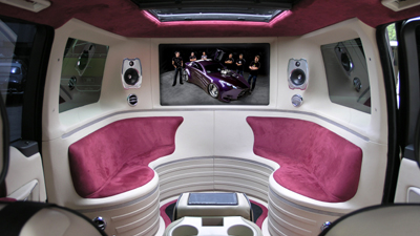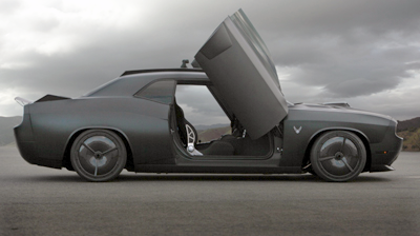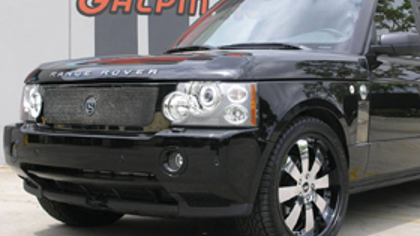Hypertherm plasma cutters help Galpin Auto Sports create dreams
Posted by
Take a quick walk through the garage at Galpin Auto Sports and you soon realize the crew there can create just about anything on wheels. Whether it's customizing a truck, restoring a classic hot rod, or tricking out a car, GAS has got it down. It helps to have an extremely talented crew and unlimited imagination, but it also helps to have the right tools and equipment. For GAS, that equipment includes having quality plasma cutters.
When the Galpin era in automotive restoration began more than half a century ago, the crew could cut metal, they just couldn't do it all that easily. It was a messy process that involved a lot of time and effort to get the result they needed. Today, cutting metal is a cinch thanks to the two plasma cutters that are now a part of the GAS garage.
The Customization Era Begins
The days of Galpinizing, as some like to call it, began in the Sixties. The company took a basic Ford van and turned it into a rolling showpiece complete with paneling and carpeting. Before long, a mini refrigerator, cabinets, cushy couch and porta-potty were added. Without intending to, GAS kicked off a conversion van craze that endured for more than two decades until Chrysler came out with the mini-van.
Custom vans were just the beginning. Without GAS, Americans may have never had sunroofs in their cars and RVs wouldn't be quite the rolling homes they have become. GAS is credited with popularizing the sunroof in the States when the company's general manager found the man who held the U.S. rights to the sunroof working at a Southern California carwash. GAS is also responsible for improving the quality and style of motor homes and igniting the 4x4 truck craze.
Plasma Cutting Takes Customization to a New Level
Thanks to plasma cutting tools, the company continues to innovate to this day. Plasma works by sending a high velocity gas, like air or nitrogen, through a small nozzle opening to create a very hot, high density arc that slices through metal.
Plasma cutting technology is gaining in popularity among people who customize and restore cars because it is much faster and easier to learn than other cutting methods, it produces a nice clean cut, and is incredibly versatile. It can cut most any type of metal; whether painted, unpainted, rusted, or dirty. And it has a smaller heat affected zone than oxyfuel so you don't have to worry about warping the metal. In addition, the metal cools quickly so there isn't a lot of wasted down time. It means that car restoration professionals and hobbyists who work with plasma can finish the job that much more efficiently.
Any Thickness, Any Metal, Any Place
Over at GAS, the automotive customization crew most often cuts metal between 1/4 and 1/2 inch thick. However, plasma is able to cut most thicknesses from gauge up to a couple of inches. Another reason car hobbyists and professionals like plasma cutting is its ability to do more than cleanly cut metal. A little known fact: plasma is great at gouging out old welds and beveling metal.
"I'm not sure how we ever modified cars without plasma," said Mad Mike, the automotive customizing supervisor over at GAS and one of the stars of MTV's Pimp My Ride. For many people who work on cars, the thought of working without plasma, is kind of like an office without a computer, or a home without a microwave. You don't really need either one, but it's hard to imagine having to work without one.
At GAS, plasma helps Mad Mike achieve the perfection he is known for. Mike says, "We use a couple of different Hypertherm systems and both are the most amazing machines. We have a hard time putting them down. They are always in use around here."
Plasma cutters like the Powermax30 and Powermax45 are super portable so the crew can pick it up and move it around the car. A tapered torch makes getting into tight places a simple job. That might be why many of the best known shops—places like Jay Leno's Big Dog Garage, Customs by Eddie Paul, HOT Motorsports and Banks Engineering—all use Hypertherm plasma cutters.
From Concept Cars to Limousines
One of GAS' more recent projects was a joint collaboration with the U.S. Air Force. Having served during Operation Desert Storm, Mad Mike jumped at the chance to work with the service on a new recruiting tool: two extreme high-tech concept cars. Mad Mike says the team used two Hypertherm products: a Powermax45 and HySpeed HSD130 extensively. "We made a lot of modifications to the car, which meant lots of cutting. Whether it was the floor of the car, brackets for the roll cage, or the Air Force logo, Hypertherm plasma cut it all like a knife through butter."
Plasma also comes in handy for "seat deletes"—GAS' name for taking a backseat out of a car. But plasma doesn't just help with removing things. It helps to put things in. One case in point, a recent request from a man who wanted to drop a 60" TV into the back of his limousine. As you might imagine, getting a 60" TV into a limo takes some thought. You can't just slide it in through the door. Thanks to plasma though, this request wasn't a problem. GAS simply grabbed a Powermax, cut the roof off and dropped in the TV. Once the TV was inside the car, the crew used their Powermax to make the brackets they needed to hold the TV in place.
Could they have done that work without plasma? Maybe. Would they have wanted to? Not a chance. When it comes to restoring and customizing cars, the guys at GAS know Hypertherm plasma is the tool they need to get the job done. As Mad Mike explains, "We cut lots of metal around here, and nothing cuts metal better than Hypertherm plasma."
Posted by





